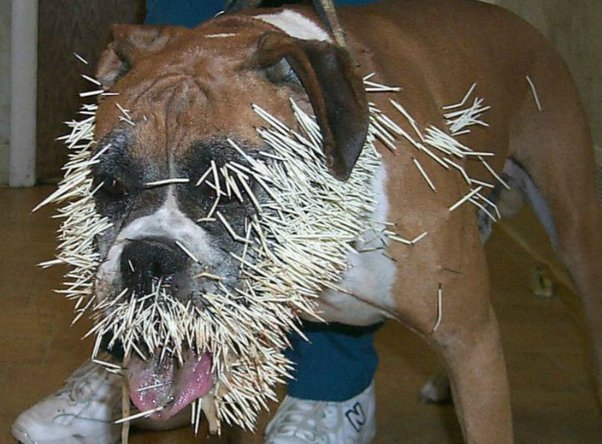Porcupines are intriguing creatures known for their quills and unique appearance.
Found in various parts of the world, these rodents are often associated with their ability to defend themselves against predators by releasing sharp quills when threatened.
In this article, we will delve into the world of porcupines and examine their physical characteristics and behaviors to determine whether or not they have the capability to scale trees.
Do Porcupines Climb Trees?
How Porcupines Climb Trees?
Porcupines have several unique features that make them well-suited for climbing trees:
Claws
Porcupines possess strong, curved claws on their front and hind feet, which allow them to grip tree bark efficiently.
Prehensile Tails
Unlike most rodents, porcupines have prehensile tails that act as an additional limb. Their tails are flexible and can wrap around branches, providing stability and balance while climbing.
Quills
While their quills may seem like a deterrent to climbing, they actually serve as an advantage. Porcupines can use their quills as anchors, digging them into the bark for additional support.
Strong Muscles
Porcupines have well-developed muscles in their limbs, particularly their forelimbs, which enable them to maneuver their bodies while ascending and descending trees.
Why Porcupine Does Tree Climbing?
Porcupines have evolved to climb trees for various reasons, including:
Escape from Predators
Tree climbing provides porcupines with a safe haven from ground-dwelling predators. By ascending a tree, they can escape danger and find refuge in the dense foliage.
Access to Food
Trees offer porcupines a buffet of delectable treats. They are herbivores and primarily feed on leaves, bark, twigs, and buds. By climbing trees, porcupines gain access to a diverse range of vegetation that may not be available at ground level.
Mating Rituals
Tree climbing plays a crucial role in porcupines’ mating rituals. During the breeding season, males may engage in impressive displays of agility and strength to attract females. Climbing trees and navigating branches demonstrates their fitness as potential mates.
Territorial Marking
Porcupines are known to mark their territory by chewing on tree bark and leaving behind distinctive scent markings. Climbing trees allows them to reach higher branches, maximizing the effectiveness of their territorial markings.
Tree-Climbing Techniques
Their specific techniques and adaptations to climb trees effectively:
Powerful Grip
With their sharp claws and strong muscles, porcupines can maintain a firm grip on tree bark. They rely on their forelimbs to pull themselves upward while securing their hind limbs for added stability.
Slow Movement
Porcupines are not known for their agility or speed. Instead, they use slow and deliberate movements, carefully selecting their footholds and maintaining a steady pace while climbing.
Tail Utilization
Porcupines’ prehensile tails are their secret weapon when it comes to tree climbing. They can curl their tails around branches, providing balance and acting as a counterweight to prevent them from tipping over.
Quill Maneuverability
Despite the risk of getting their quills tangled in branches, porcupines can manipulate their quills to avoid entanglement. They flatten their quills against their bodies or raise them slightly, allowing them to navigate through tight spaces without obstruction.
Do All Porcupine Species Climb Trees?
While tree climbing is a common behavior among porcupines, not all species exhibit this skill to the same extent. Some species, such as the North American porcupine (Erethizon dorsatum), are excellent climbers and spend a significant portion of their lives in trees.
Species like the Cape porcupine (Hystrix africaeaustralis) are more terrestrial and spend less time in trees.
North American Porcupine
The North American porcupine, widely known for its tree-climbing prowess, is the largest porcupine species in the United States and Canada.
It has exceptionally well to arboreal life. Here are some interesting facts about this creature:
The North American porcupine has a stocky build, measuring up to 2 feet long and weighing between 10 to 40 pounds.
Its coat is covered in approximately 30,000 quills, which serve as defense mechanisms against predators.
Despite their sharp appearance, porcupine quills are not venomous. However, they can become embedded in a predator’s skin, causing discomfort and potential infection.
North American porcupines are mostly nocturnal and spend their days resting in tree branches.
They are skilled climbers and can ascend trees as high as 60 feet.
Their diet consists mainly of bark, twigs, leaves, and green plants.
During cold winter months, porcupines rely on their climbing abilities to access the tender bark beneath the snow.
How they Interactions with Humans?
While porcupines generally prefer to avoid human contact, their tree-climbing behavior can sometimes lead to interactions. Here are a few points to consider:
Porcupines may occasionally find their way into residential areas, attracted by trees and vegetation. This can lead to encounters with homeowners.
When threatened, porcupines will raise their quills and may attempt to climb trees to escape. It’s advisable to keep a safe distance to avoid getting injured by their quills.
Porcupines’ chewing habits can damage trees and may require preventive measures to protect valuable vegetation.
It’s important to note that capturing or harming porcupines is generally not recommended. They play an essential role in ecosystems and contribute to the balance of nature.
FAQ
Q: Do porcupines throw their quills?
A: Contrary to popular belief, porcupines don’t throw their quills. Instead, they have specialized quills that detach easily upon contact, embedding into an attacker.
Q: Do porcupines hibernate?
A: Porcupines do not hibernate but may become less active during extreme cold weather, relying on stored fat reserves and seeking shelter to conserve energy.
Q: Are porcupines rodents?
A: Despite their appearance, porcupines are not rodents. They belong to the group of rodents known as “hystricomorphs,” which includes other species like guinea pigs and capybaras.
Q: Can porcupines climb trees?
A: Porcupines are indeed capable climbers and can climb trees with ease.

🐾 I’m Marquis, an animal enthusiast 🦁🐯 with a passion for both wild and home animal care. In the wild, I’ve studied majestic species like 🦍🐅, collaborating with conservationists. At home, I’m all about fostering loving environments for pets 🐶🐱🐦, with hands-on experience and shelter volunteering.



Leave a Reply